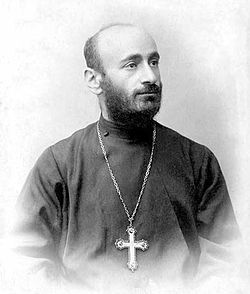Komitas | |
|---|---|
Կոմիտաս | |
 | |
| Born | Soghomon Soghomonian 8 October [O.S. 26 September] 1869 |
| Died | 22 October 1935 (aged 66) Paris, France |
| Resting place | Komitas Pantheon |
| Nationality | Armenian |
| Education | Gevorgian Seminary Frederick William University |
| Occupation(s) | Musicologist, composer, choirmaster |
| Years active | 1891–1915 |
| Website | komitasmuseum.am |
| Signature | |
 | |
Soghomon Soghomonian,[A] ordained and commonly known as Komitas[B] (Armenian: Կոմիտաս; 8 October [O.S. 26 September] 1869 – 22 October 1935), was an Ottoman-Armenian priest, musicologist, composer, arranger, singer, and choirmaster, who is considered the founder of the Armenian national school of music.[4][7] He is recognized as one of the pioneers of ethnomusicology.[8][9]
Orphaned at a young age, Komitas was taken to Etchmiadzin, Armenia's religious center, where he received education at the Gevorgian Seminary. Following his ordination as vardapet (celibate priest) in 1895, he studied music at the Frederick William University in Berlin. He thereafter "used his Western training to build a national tradition".[10] He collected and transcribed over 3,000 pieces of Armenian folk music, more than half of which were subsequently lost and only around 1,200 are now extant. Besides Armenian folk songs, he also showed interest in other cultures and in 1903 published the first-ever collection of Kurdish folk songs titled Kurdish melodies. His choir presented Armenian music in many European cities, earning the praise of Claude Debussy, among others. Komitas settled in Constantinople in 1910 to escape mistreatment by ultra-conservative clergymen at Etchmiadzin and to introduce Armenian folk music to wider audiences. He was widely embraced by Armenian communities, while Arshag Chobanian called him the "savior of Armenian music".[11]
During the Armenian genocide—along with hundreds of other Armenian intellectuals—Komitas was arrested and deported to a prison camp in April 1915 by the Ottoman government. He was soon released under unclear circumstances and, having witnessed indiscriminate cruelty and relentless massacres of other Armenians by the Ottoman Turks, Komitas experienced a mental breakdown and developed a severe case of post-traumatic stress disorder (PTSD). The widespread hostile environment in Constantinople and reports of mass-scale Armenian death marches and massacres that reached him further worsened his fragile mental state. He was first placed in a Turkish military-operated hospital until 1919 and then transferred to psychiatric hospitals in Paris, where he spent the last years of his life in agony. Komitas is widely seen as a martyr of the genocide and has been depicted as one of the main symbols of the Armenian Genocide in art.[12] Collection of Works of the Composer Komitas Vardapet is included to UNESCO Memory of the World Register.
- ^ Soulahian Kuyumjian 2001, p. 46.
- ^ "Etchmiadzin. 1902". Virtual Museum of Komitas. Retrieved 21 February 2014.
- ^ Lang, David Marshall (1980). Armenia: Cradle of Civilization. London: Allen & Unwin. p. 256. ISBN 9780049560079.
- ^ a b "Komitas". Encyclopædia Britannica. Retrieved 26 January 2014.
Komitas [...] created the basis for a distinctive national musical style in Armenia.
- ^ "The Monthly Musical Record". The Monthly Musical Record. 30. London: Augener: 15. 1900.
- ^ Soulahian Kuyumjian 2001, pp. 45–46.
- ^ Editorial Board (1969). "Հայ ազգային երաժշտության հիմնադիրը [The Founder of Armenian National Music]". Lraber Hasarakakan Gitutyunneri (in Armenian) (11). Yerevan: Armenian Academy of Sciences: 3–6. Archived from the original on 21 May 2017. Retrieved 29 November 2014.
- ^ Poladian 1972: "He was among the pioneers in ethnomusicology, a younger contemporary of Carl Stumpf (1848–1936)."
- ^ McCollum, Jonathan Ray (2004). "Music, Ritual, And Diasporic Identity: A Case Study Of The Armenian Apostolic Church" (PDF). University of Maryland. p. 11. Retrieved 4 February 2014.
Komitas Vardapet, considered a pioneer in ethnomusicology, turned his attention to the anthropological, sociological, and historical aspects of comparative musicology.
- ^ Crutchfield, Will (5 October 1987). "Music Noted in Brief; Choir From Armenia at Avery Fisher Hall". The New York Times. Retrieved 26 January 2014.
- ^ Soulahian Kuyumjian 2001, p. 51.
- ^ Soulahian Kuyumjian, Rita. Archeology of Madness: Komitas, Portrait of an Armenian Icon. Edition: 2, Reading, England: Taderon Press; Princeton, NJ: Gomidas Institute, 2001, p. 3.
Cite error: There are <ref group=upper-alpha> tags or {{efn-ua}} templates on this page, but the references will not show without a {{reflist|group=upper-alpha}} template or {{notelist-ua}} template (see the help page).